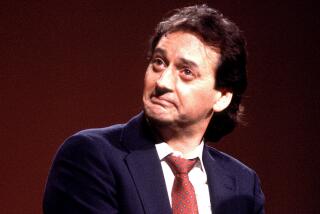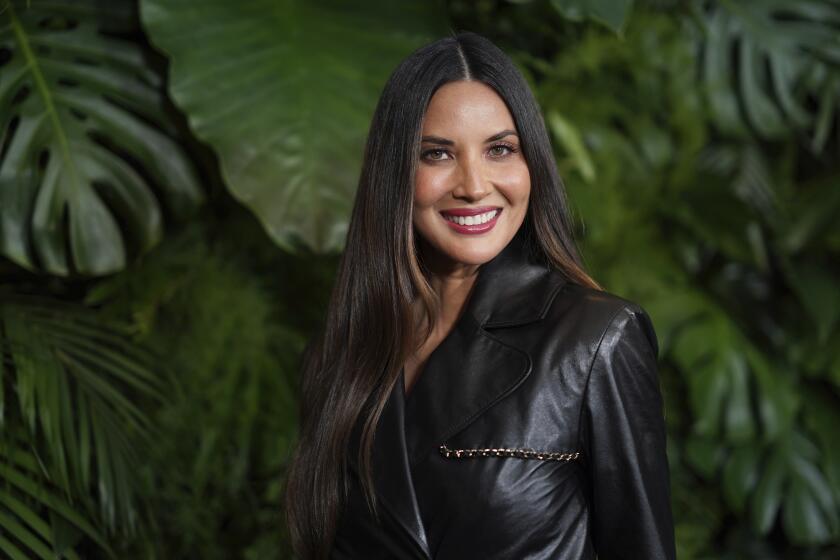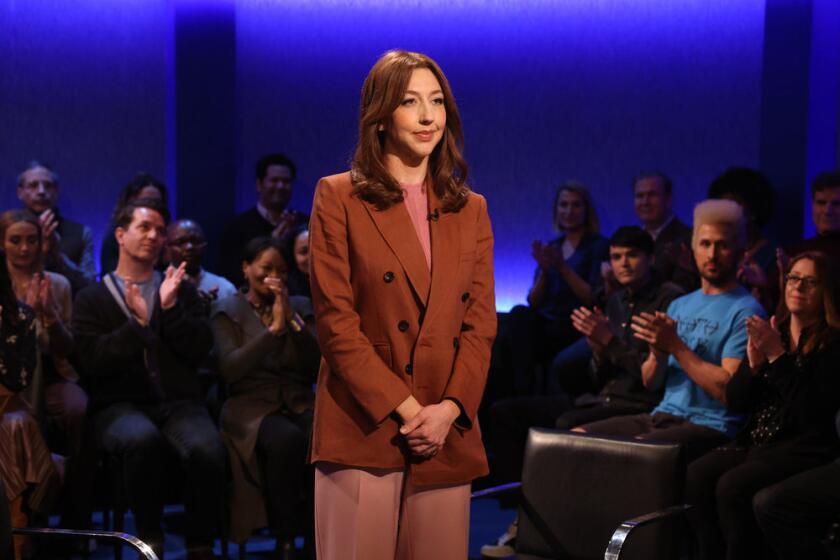Still crazy after all these 50 years: Lily Tomlin and producer George Schlatter reminisce about ‘Rowan & Martin’s Laugh-In.’
Once upon a time in TV Land, a sketch-comedy show from “beautiful downtown Burbank” swept through prime time like a comic cyclone.
The weekly mayhem was anchored by two relatively straitlaced comedians in tuxedos and included a bizarre array of characters: a cigarette-puffing German who found everything “veeerry interesting”; a hairnet-wearing spinster who was constantly harassed by a grumbling dirty old man; a snarky telephone operator who would harass customers; and a goofy blond named Goldie who danced with all sorts of weird markings scribbled on her bikini-clad body.
And then there was the flurry of catch phrases: “Here comes the judge,” “You bet your sweet bippy,” ”Sock it to me!” and — punctuated by a bratty raspberry — “And that’s the truth.”
Nothing on TV resembled “Rowan & Martin’s Laugh-In” when the hourlong series premiered in 1968 on NBC, and nothing has really looked like it since it left the air in 1973. Although “Saturday Night Live,” “MADtv” and other sketch shows have captured some of the flavor of “Laugh-In,” no other comedy show has matched it in terms of its hyper-speed outrageousness and offbeat sensibility.
“People had never seen anything like it,” said creator and producer George Schlatter in a phone interview. “There were no rules. It was a moment of utopian TV. It was a collection of an enormous group of people who were very talented, dedicated and outrageous at a time when outrageousness was coming into vogue.”
“We were beloved,” added actress-comedian-playwright Lily Tomlin, a member of the large “Laugh-In” cast, which included Goldie Hawn, Ruth Buzzi, Henry Gibson, Arte Johnson, Jo Anne Worley, Judy Carne, Alan Sues and Gary Owens. “It was such a phenomena, every star in Hollywood wanted to come on.”
To commemorate the 50th anniversary of the show, Time Life is releasing a new DVD box set, “Rowan and Martin’s Laugh-In: The Complete Series,” that contains all 140 complete episodes broadcast during the show’s six seasons. (More than 60% of the installments have never been available on home video.)
The timing of the release seems particularly relevant, said Schlatter, who produced several TV shows and specials throughout his extensive career, including lengthy associations with the Grammy Awards and Rat Packers like Frank Sinatra and Sammy Davis Jr.
“‘Laugh-In’ was always a feel-good show, and right now, I think there’s an appetite for people to feel good again,” he said. “All the things we were talking about in 1968 are things we’re talking about today. We have an unpopular war, an unpopular president, the military. It’s like those things have never really gone away.”
The variety series originated as a one-time special in 1967. The show made such an impression that it was bought back as a series the following year, taking the place of “The Man From U.N.C.L.E.”
Some industry observers have credited the show with giving presidential candidate Richard Nixon a major boost when he appeared in a brief cameo.
Mixing a psychedelic vibe with a torrent of silly one-liners, double-entendres and pointed social and political commentary, “Laugh-In” was so influential and had such a grip on pop culture that some industry observers have credited the show with giving presidential candidate Richard Nixon a major boost when he appeared in a brief cameo and awkwardly uttered “Sock it to me?”
The cast was huge and culturally diverse, and many of them, including Gibson, who offered little poems, loud-voiced Worley and “Sock it to me” girl Carne, became audience favorites.
The then-unknown Hawn went from playing a “really dumb blond” to winning an Oscar for supporting actress in 1970 for her first major movie role in “Cactus Flower.” Her versatile and busy career includes her recent teaming with Amy Schumer for the mother-daughter comedy “Snatched.”
Tomlin had a hugely successful career following “Laugh-In” in films like “Short Cuts,” “9 to 5” and “Nashville,” the last of which garnered her an Oscar nomination for supporting actress. Her acclaimed one-woman stage show, “The Search for Signs of Intelligent Life in the Universe,” brought her a Tony Award. And she currently costars with her “9 to 5” pal Jane Fonda in the Netflix comedy “Grace and Frankie,” for which she was nominated for Emmys in 2015 and ’16.
Schlatter said the risqué humor of “Laugh-In” often pushed the envelope: “We had six censors. They would be looking for something, and then we would do something else.”
The series attracted top guest stars including John Wayne, Debbie Reynolds, Sonny & Cher, Kirk Douglas, Diana Ross and Jack Lemmon. Announcer Owens would introduce the proceedings with a hand cupped over his ear. A long-haired, high-voiced crooner named Tiny Tim strummed a ukulele and crooned “TipToe Thru’ the Tulips With Me.”
“And when you had moments like John Wayne standing next to Tiny Tim, well, you can’t get better than that,” says Schlatter with a chuckle at the memory.
“‘Laugh-In’ was such an important and pioneering show in so many ways,” said Ken Feil, author of the 2014 book “Rowan & Martin’s Laugh-In.” “The show had this strategy to insert or introduce controversial content into a mainstream TV show.”
Its approach to comedic riffs on topical issues helped pave the way for acclaimed series like “All in the Family” and “Maude” and, thanks to its relentless pace, even Matt Groening, creator of “The Simpsons,” cites it as an influence, said Feil in a phone interview. “The jokes were pelted at the audience so quickly.”
Feil also likened Nixon’s appearance on the show to the current trend of politicians appearing on talk shows and poking fun at themselves. “That’s probably the most famous example, and you can see a direct relevance to President Donald Trump.”
Of the Nixon cameo, Schlatter says, “People tell me his appearance on ‘Laugh-In’ is probably what got him elected again. I have to live with that. He was definitely not a comedian, but he was a lot funnier than folks might think.”
Tomlin said doing the show was often chaotic: “There was no audience. They would be setting up a set for a joke, filming another joke and breaking down another set all at the same time.”
She recalled one instance when ventriloquist Edgar Bergen and his dummy, Charlie McCarthy, were on the set. “Edgar didn’t move, but Charlie McCarthy turned his head to look,” she said with a laugh.
Tomlin joined the show in the third season and introduced two of its most memorable characters — Ernestine, the gossipy switchboard operator with the snort who would say, “One ringy dingy, two ringy dingy” and “Have I reached the party to whom I am speaking?,” and Edith Ann, the bratty little girl who sat in an oversize chair and offered her own humorous takes on life.
“Ernestine was an overnight success. I was just stunned,” said Tomlin. “I would be in the market in Malibu, and people would stop me, wanting me to do her.”
Fans have approached Schlatter for years about reviving “Laugh-In.”
“It would be so much simpler to do it now than it was then,” he said. “We need it now more than ever.”
Twitter:@GeBraxton
More to Read
The complete guide to home viewing
Get Screen Gab for everything about the TV shows and streaming movies everyone’s talking about.
You may occasionally receive promotional content from the Los Angeles Times.







